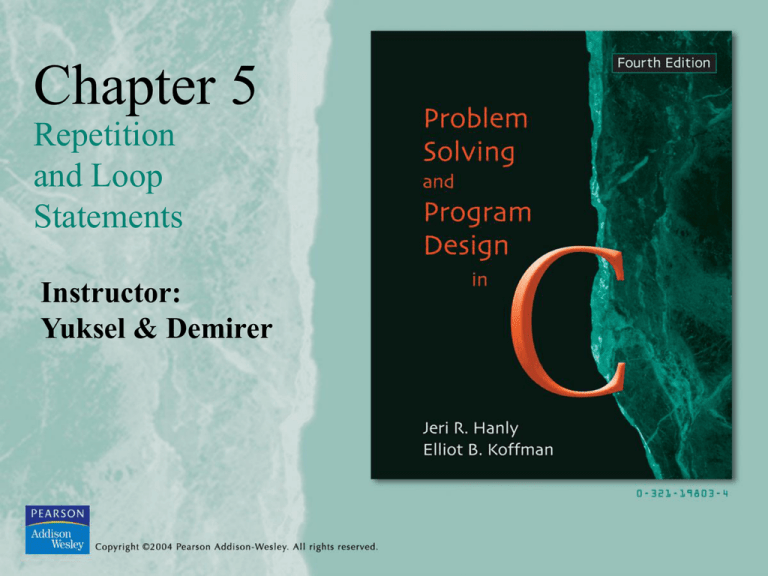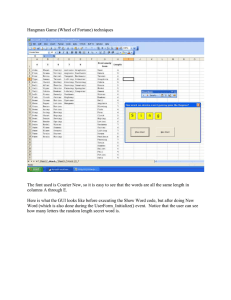
Chapter 5
Repetition
and Loop
Statements
Instructor:
Yuksel & Demirer
Repetition in Programs
• In most software, the statements in the program
may need to repeat for many times.
– e.g., calculate the value of n!.
– If n = 10000, it’s not elegant to write the code as
1*2*3*…*10000.
• Loop is a control structure that repeats a group
of steps in a program.
– Loop body stands for the repeated statements.
• There are three C loop control statements:
– while, for, and do-while.
Copyright ©2004 Pearson Addison-Wesley. All rights reserved.
5-2
Flow Diagram of Loop Choice Process
e.g., read the content in a file
e.g., calculate the value of n!
Copyright ©2004 Pearson Addison-Wesley. All rights reserved.
5-3
Comparison of Loop Choices (1/2)
Kind
Counting loop
When to Use
C Structure
We know how many loop while, for
repetitions will be needed
in advance.
SentinelInput of a list of data ended while, for
controlled loop by a special value
EndfileInput of a list of data from
controlled loop a data file
Copyright ©2004 Pearson Addison-Wesley. All rights reserved.
while, for
5-4
Comparison of Loop Choices (2/2)
Kind
When to Use
C Structure
Input validation Repeated interactive input do-while
loop
of a value until a desired
value is entered.
General
Repeated processing of
while, for
conditional
data until a desired
loop
condition is met.
Copyright ©2004 Pearson Addison-Wesley. All rights reserved.
5-5
The while Statement in C
• The syntax of while statement in C:
while (loop repetition condition)
statement
• Loop repetition condition is the condition
which controls the loop.
• The statement is repeated as long as the loop
repetition condition is true.
• A loop is called an infinite loop if the loop
repetition condition is always true.
Copyright ©2004 Pearson Addison-Wesley. All rights reserved.
5-6
An Example of a while Loop
Loop repetition condition
Statement
Loop control variable is the variable whose value controls
loop repetition.
In this example, count_emp is the loop control variable.
Copyright ©2004 Pearson Addison-Wesley. All rights reserved.
5-7
Flowchart for a while Loop
Loop repetition condition
Statement
Copyright ©2004 Pearson Addison-Wesley. All rights reserved.
5-8
Compound Assignment Operators
(1/2)
• The loop body usually consists of statements of
the form: variable = variable op expression.
– e.g., count_emp = count_emp + 1;
• C provides compound assignment operators
which enable a more concise notation for this
kind of statements.
– “variable op = expression” is the same to
“variable = variable op expression.”
Copyright ©2004 Pearson Addison-Wesley. All rights reserved.
5-9
Compound Assignment Operators (2/2)
Simple Assignment
Operators
count_emp =
count_emp + 1;
time = time -1;
Compound Assignment
Operators
count_emp += 1;
product = product *
item;
total = total /
number;
n = n % (x+1);
product *= item;
Copyright ©2004 Pearson Addison-Wesley. All rights reserved.
time -= 1;
total /= number;
n %= x+1;
5-10
The for Statement in C
• The syntax of for statement in C:
for (initialization expression;
loop repetition condition;
update expression)
statement
• The initialization expression set the initial value of the
loop control variable.
• The loop repetition condition test the value of the loop
control variable.
• The update expression update the loop control variable.
Copyright ©2004 Pearson Addison-Wesley. All rights reserved.
5-11
An Example of the for Loop
Initialization Expression
Loop repetition condition
Update Expression
count_emp is set to 0 initially.
count_emp should not exceed the value of number_emp.
count_emp is increased by one after each iteration.
Copyright ©2004 Pearson Addison-Wesley. All rights reserved.
5-12
Increment and Decrement Operators
• The statements of increment and decrement are
commonly used in the for loop.
• The increment (i.e., ++) or decrement (i.e., --)
operators are the frequently used operators
which take only one operand.
• The increment/decrement operators increase or
decrease the value of the single operand.
– e.g., for (int i = 0; i < 100; i++){ … }
– The variable i increases one after each iteration.
Copyright ©2004 Pearson Addison-Wesley. All rights reserved.
5-13
Comparison of Prefix and Postfix
Increments
The value of the expression (that uses the ++/-- operators)
depends on the position of the operator.
The value
of j is
increased
Copyright ©2004 Pearson Addison-Wesley. All rights reserved.
The value
of j is not
increased
5-14
Sentinel-Controlled Loops
• Sometimes we may not know how many times
the loop will repeat.
• One way to do this is to choose a sentinel value
as an end marker.
– The loop exits when the sentinel value is read.
• If the user wish to exit the loop, he or she has to
input the sentinel value.
– It is similar to the “logout” function in many
applications.
Copyright ©2004 Pearson Addison-Wesley. All rights reserved.
5-15
An Example of Sentinel-Controlled
while Loops
If the user wish to exit the loop,
he or she has to input -99.
Copyright ©2004 Pearson Addison-Wesley. All rights reserved.
5-16
An Example of Endfile-Controlled
Loops
• fscanf is a function used to read file.
• EOF stands for the special value of end-file returned by
fscanf.
• This loop repeats until reading the end of the file.
Copyright ©2004 Pearson Addison-Wesley. All rights reserved.
5-17
Nested Loops
• Usually used to work with two dimensional arrays
(later).
• Nested loops consist of an outer loop with or more
inner loops.
• Each time the outer loop is repeated, the inner loops are
reentered
– Their loop control expressions are reevaluated
– All required iterations are performed again.
Copyright ©2004 Pearson Addison-Wesley. All rights reserved.
5-18
Nested Loops
• Nested loops consist of an outer loop with one
or more inner loops.
• e.g.,
Outer loop
for (i=1;i<=100;i++){
for(j=1;j<=50;j++){
…
Inner loop
}
}
• The above loop will run for 100*50 iterations.
Copyright ©2004 Pearson Addison-Wesley. All rights reserved.
5-19
What is the Output?
lcv1 = 0;
sum = 0;
while (lcv1 < 100)
{
lcv2 = 0;
while (lcv2 < 100)
{
sum = sum + 1;
lcv2++;
}
lcv1++;
}
printf(“Sum is %d\n”, sum);
/* Output = */
Sum is 10000
Copyright ©2004 Pearson Addison-Wesley. All rights reserved.
5-20
What is the Output?
int a=0, b=0, sum=0;
for(a=0; a<6; a+=2)
for(b=0; b>4; b--)
sum=sum+1;
printf(“%d”,sum);
/* Output = */
Sum is 0
Copyright ©2004 Pearson Addison-Wesley. All rights reserved.
5-21
Do While statement
• Both the for statement and the while statement
evaluate the loop condition before the first
execution of the loop body.
• In most cases, this pre-test is desirable and
prevents the loop from executing when there
may be no data items to process
• There are some situations, generally involving
interactive input, when we know that a loop
must execute at least one time.
Copyright ©2004 Pearson Addison-Wesley. All rights reserved.
5-22
The do-while Statement in C
• The syntax of do-while statement in C:
do
statement
while (loop repetition condition);
• The statement is first executed.
• If the loop repetition condition is true, the
statement is repeated.
• Otherwise, the loop is exited.
Copyright ©2004 Pearson Addison-Wesley. All rights reserved.
5-23
An Example of the do-while Loop
/* Find even number input */
do{
printf(“Enter a value: ”);
scanf(“%d”, &num);
}while (num % 2 !=0)
This loop will repeat if the user
inputs odd number.
Copyright ©2004 Pearson Addison-Wesley. All rights reserved.
5-24
Do-While Example
do
{
printf("Enter a letter from A through E> ");
scanf("%c", &letter_choice);
}while (letter_choice < ’A’ || letter_choice > ’E’);
Copyright ©2004 Pearson Addison-Wesley. All rights reserved.
5-25
Flag Controlled Loops
• Sometimes a loop repetition condition becomes so complex
that placing the full expression in its usual spot is awkward.
• In many cases, the condition may be simplified by using a
flag.
while (flag)
{
….
}
• A flag is a type int variable used to represent whether or not
a certain event has occurred.
• A flag has one of two values: 1 (true) and 0 (false).
Copyright ©2004 Pearson Addison-Wesley. All rights reserved.
5-26
Endfile-controlled loops
• Many library functions return helpful data as the value of the
function.
• For example, scanf returns the number of data items it
actually obtained.
num = scanf(“%d%d%d”, &n1, &n2, &n3);
• A data file is always terminated by an endfile character (EOF)
that can be detected by the scanf and fscanf functions.
• You can write a program that processes a list of data of any
length from a file without requiring a special sentinel value at
the end of the data file.
Copyright ©2004 Pearson Addison-Wesley. All rights reserved.
5-27
#include <stdio.h>
int main(void) {
FILE *inp;
int sum = 0, score, input_status;
inp = fopen("scores.dat", "r");
input_status = fscanf(inp, "%d", &score);
while (input_status != EOF)
{
printf("%d ", score);
sum += score;
input_status = fscanf(inp, "%d",
&score);
}
printf("\nSum of exam scores is %d\n", sum);
fclose(inp);
return 0;
}
/* Output */
55 33 77
Sum of exam scores is 165
Copyright ©2004 Pearson Addison-Wesley. All rights reserved.
5-28
What is the Output?
int i, sum=0,status=0;
status = scanf(“%d”,&i);
while(status!=EOF)
{
/* Input = */
2
4
6
ctl-d
sum+=i;
status = scanf(“%d”,&i);
}
/* Output = */
12
printf(“%d\n”, sum);
Copyright ©2004 Pearson Addison-Wesley. All rights reserved.
5-29
In class work (1/2)
• Write a program that prompts the user to input
an integer n.
• Draw a triangle with n levels by star symbols.
For example,
n = 3,
*
**
***
• After drawing the triangle, repeat the above
process until the user input a negative integer.
Copyright ©2004 Pearson Addison-Wesley. All rights reserved.
5-30
In class work #4 (2/2)
• An usage scenario:
Please input: 2
*
**
Please input: 3
*
**
***
Please input: -9
Thank you for using this program.
Copyright ©2004 Pearson Addison-Wesley. All rights reserved.
5-31

